The Comet And The Star Cluster : Comet Linear Has Become Unexpectedly Bright. The Comet, Discovered In

The Comet and the Star Cluster : Comet Linear has become unexpectedly bright. The comet, discovered in 2000, underwent a 100-fold outburst just a week before it passed a mere 14 lunar distances from Earth late last month. The comet was captured here last week at about magnitude 6 just bright enough to be seen by the unaided eye passing in front of the distant globular star cluster M14. Comet 252/P LINEAR is one of a rare group of comets that vacillate between the Earth and Jupiter every 5 years. How the comet will evolve from here is unknown, but hopes run high that it will remain a good object for binoculars in northern skies for the next week or two. via NASA
js
More Posts from Xyhor-astronomy and Others








TODAY IN HISTORY: Behold these beautiful shots of the Earth taken from the Gemini 5 spacecraft on August 25, 1965.
(NASA/ASU)
Chasing the Shadow of Neptune’s Moon Triton
Our Flying Observatory

Our flying observatory, called SOFIA, carries a 100-inch telescope inside a Boeing 747SP aircraft. Scientists onboard study the life cycle of stars, planets (including the atmosphere of Mars and Jupiter), nearby planetary systems, galaxies, black holes and complex molecules in space.
AND in just a few days SOFIA is going on a special flight to chase the shadow of Neptune’s moon Triton as it crosses Earth’s surface!
In case you’re wondering, SOFIA stands for: Stratospheric Observatory for Infrared Astronomy.
Triton

Triton is 1,680 miles (2,700 km) across, making it the largest of the 13 moons orbiting Neptune. Unlike most large moons in our solar system, Triton orbits in the opposite direction of Neptune, called a retrograde orbit. This backward orbit leads scientists to believe that Triton formed in an area past Neptune, called the Kuiper Belt, and was pulled into its orbit around Neptune by gravity.
The Voyager 2 spacecraft flew past Neptune and Triton in 1989 and found that Triton’s atmosphere is made up of mostly nitrogen…but it has not been studied in nearly 16 years!
Occultations are Eclipse-Like Events

An occultation occurs when an object, like a planet or a moon, passes in front of a star and completely blocks the light from that star. As the object blocks the star’s light, it casts a faint shadow on Earth’s surface.
But unlike an eclipse, these shadows are not usually visible to the naked eye because the star and object are much smaller and not nearly as bright as our sun. Telescopes with special instruments can actually see these shadows and study the star’s light as it passes near and around the object – if they can be in the right place on Earth to catch the shadow.
Chasing Shadows

Scientists have been making advanced observations of Triton and a background star. They’ve calculated exactly where Triton’s faint shadow will fall on Earth! Our SOFIA team has designed a flight path that will put SOFIA (the telescope and aircraft) exactly in the center of the shadow at the precise moment that Triton and the star will align.
This is no easy feat because the shadow is moving at more than 53,000 mph while SOFIA flies at Mach 0.85 (652 mph), so we only have about two minutes to catch the shadow!! But our SOFIA team has previously harnessed the aircraft’s mobility to study Pluto from inside the center of its occultation shadow, and is ready to do it again to study Triton!
What We Learn From Inside the Shadow

From inside the shadow, our team on SOFIA will study the star’s light as it passes around and through Triton’s atmosphere. This allows us to learn more about Triton’s atmosphere, including its temperature, pressure, density and composition!
Our team will use this information to examine if Triton’s atmosphere has changed since our Voyager 2 spacecraft flew past it in 1989. That’s a lot of information from a bit of light inside a shadow! Similar observations of Uranus in 1977, from our previous flying observatory, led to the discovery of rings around that planet!
International Ground-Based Support

Ground-based telescopes across the United States and Europe – from Scotland to the Canary Islands – will also be studying Triton’s occultation. Even though most of these telescopes will not be in the center of the shadow, the simultaneous observations, from different locations on Earth, will give us information about how Triton’s atmosphere varies across its latitudes.
This data from across the Earth and from onboard SOFIA will help researchers understand how Triton’s atmosphere is distorted at different locations by its high winds and its strong tides!
Make sure to follow us on Tumblr for your regular dose of space: http://nasa.tumblr.com.
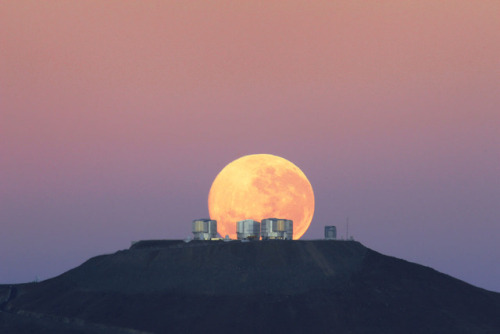
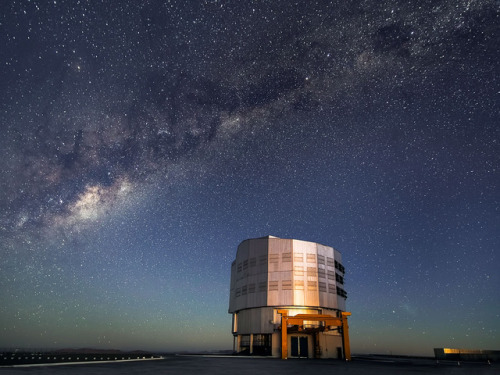
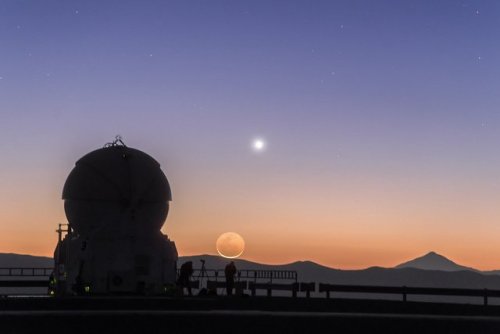
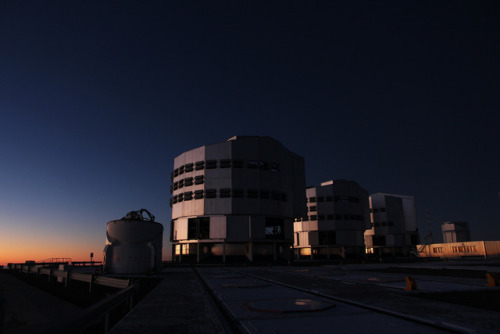
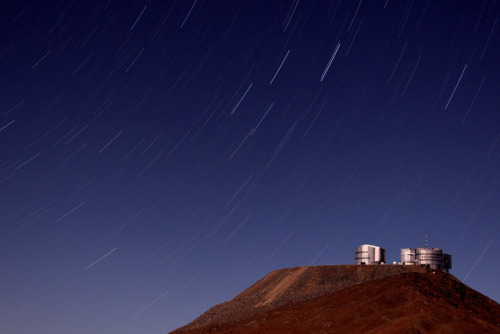
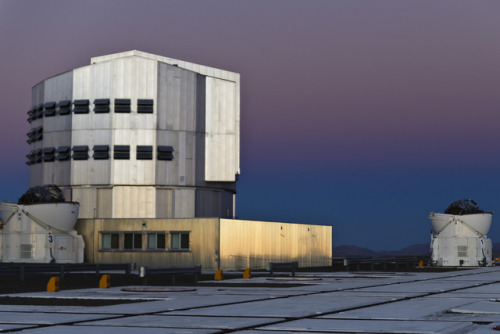
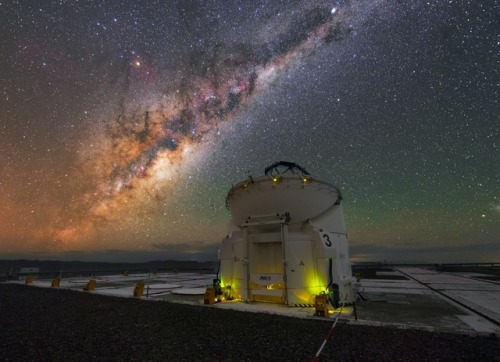
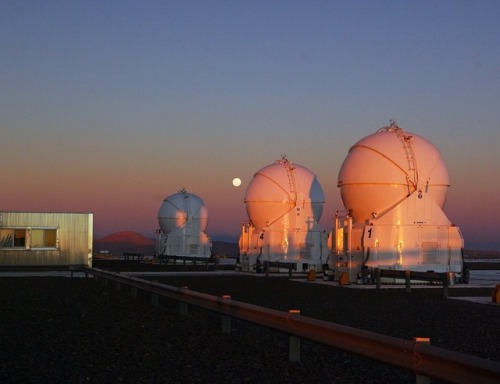
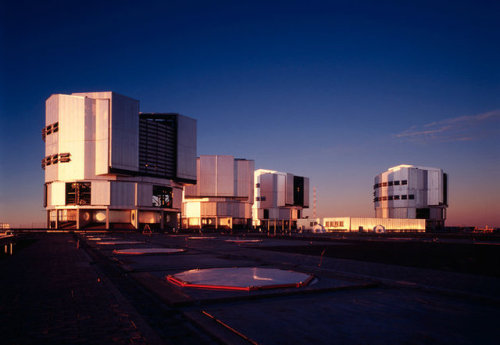
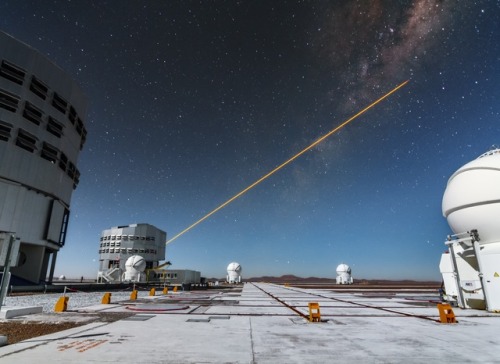
Very Large Telescope (VLT)
The Very Large Telescope (VLT) it is the world’s most advanced optical instrument, consisting of four Unit Telescopes with main mirrors of 8.2m diameter and four movable 1.8m diameter Auxiliary Telescopes.
The telescopes can work together, to form a giant ‘interferometer’, the ESO Very Large Telescope Interferometer, allowing astronomers to see details up to 25 times finer than with the individual telescopes. The light beams are combined in the VLTI using a complex system of mirrors in underground tunnels where the light paths must be kept equal to distances less than 1/1000 mm over a hundred metres. With this kind of precision the VLTI can reconstruct images with an angular resolution of milliarcseconds, equivalent to distinguishing the two headlights of a car at the distance of the Moon.
The 8.2m diameter Unit Telescopes can also be used individually. With one such telescope, images of celestial objects as faint as magnitude 30 can be obtained in a one-hour exposure. This corresponds to seeing objects that are four billion (four thousand million) times fainter than what can be seen with the unaided eye.
Source & images: eso.org
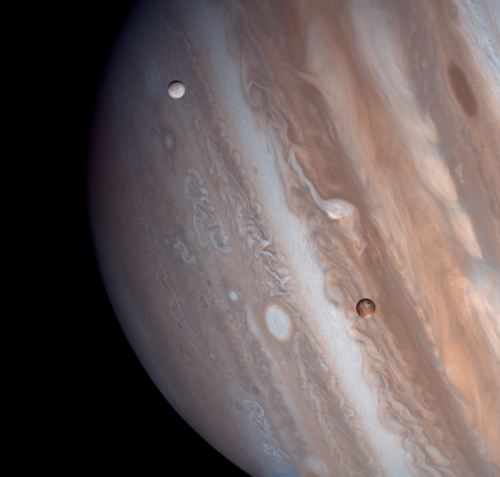
Io and Europa taken by the Voyager 1 spacecraft in 1979
Image credit: Justin Cowart

2017 October 30
Orionid Meteors from Orion Image Credit & Copyright: Lu Shupei
Explanation: Meteors have been shooting out from the constellation of Orion. This was expected, as October is the time of year for the Orionids Meteor Shower. Pictured here, over a dozen meteors were caught in successively added exposures last weekend over Wulan Hada volcano in Inner Mongolia, China. The featured image shows multiple meteor streaks that can all be connected to a single small region on the sky called the radiant, here visible just above and to the left of the belt of Orion, The Orionids meteors started as sand sized bits expelled from Comet Halley during one of its trips to the inner Solar System. Comet Halley is actually responsible for two known meteor showers, the other known as the Eta Aquarids and visible every May. Next month, the Leonids Meteor Shower from Comet Tempel-Tuttle should also result in some bright meteor streaks.
∞ Source: apod.nasa.gov/apod/ap171030.html
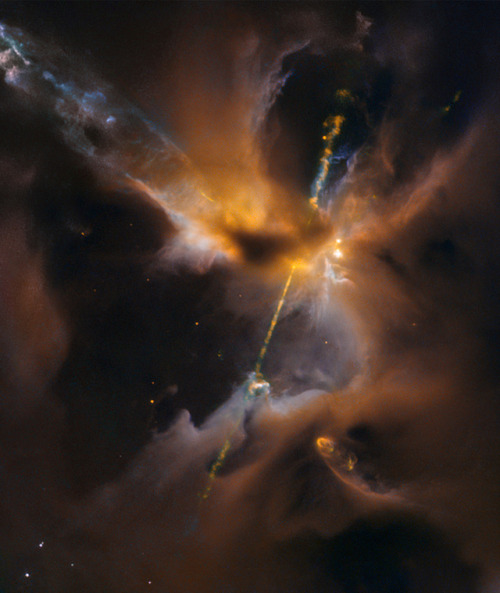
Hubble Sees the Force Awakening in a Newborn Star
This celestial lightsaber does not lie in a galaxy far, far away, but rather inside our home galaxy, the Milky Way. It’s inside a turbulent birthing ground for new stars known as the Orion B molecular cloud complex, located 1,350 light-years away.
In the center of the image, partially obscured by a dark, Jedi-like cloak of dust, a newborn star shoots twin jets out into space as a sort of birth announcement to the universe
Credit: NASA/ESA
Solar System: 10 Things to Know This Week...Halloween Edition!
This week, we’re getting into the Halloween spirit with 10 spooktacular things to let your imagination run wild.

It’s not Halloween without our favorite scary characters, but what if they could stop bothering us Earthlings and go far, far away? We begin with where Dracula, Frankenstein, and other creepy creatures might choose to live if the galaxy were theirs to claim…
1. The dark (k)night.

The prince of darkness himself, Dracula, can finally seek sweet respite from the Sun. We think he’d love to live on a rocky planet named YZ Ceti d that orbits so close to its red star that it’s tidally locked keeping one side of the planet in perpetual nighttime and the other side in perpetual daytime, with a brilliant red sky (though we can guess which side Dracula will prefer).
2. Where art thou, werewolves?

Home sweet home for our furry Full Moon friends might just be on Trappist-1, a planetary system with seven planets—and where standing on one planet would mean the other planets look like six moons (some as big as our Moon in the sky).
3. Left in the dust.

We couldn’t think of anyone better to live on Proxima b than The Mummy. Hopefully this ancient monster can finally rest in peace on an exoplanet that scientists theorize is a desert planet once home to ancient oceans.
4. Cloudy with a chance of Frankenstein.

One scientific experiment we’d like to conduct: whether Frankenstein would rather live on HAT-P-11b or Kepler-3b, theorized to have fierce thunderstorms and lightning.
5. The walking dead.

We’re pretty confident that if zombies were to pick a planet, they’d want one that shares their love of death and destruction. We think they’d feel right at home on one of the pulsar planets, which are scorched by radiation because they orbit a dead star.
6. Rest your weary bones.

Skeletons need look no further: Osiris, an exoplanet that’s so close to a star that it’s “losing its flesh” as the star destroys it, seems like a perfect match.
7. Enough of the scary stuff.

For kids out there, turn pumpkin decorating into an out-of-this-world activity with space-themed stencils, from Saturn to the Sun.
8. Spooky sounds.

Cassini’s radio emissions from Saturn could give creaky doors and howling winds a run for their money. Listen to the eerie audio recordings here and find more HERE.
9. Pumpkin-carve like a NASA engineer.

NASA engineers design and build robots that can fly millions of miles to study other planets for a living—so on Halloween, they can’t help but bring that creative thinking to the grand old tradition of pumpkin carving. Take a cue from their creations with these insider tips.
10. Detective for a day.

From blades of ice on Pluto to a fuzzy, white “bunny” photographed on Mars, become a solar system sleuth and see if you can solve the stellar mysteries in this slideshow (then compare with how scientists cracked the case).
Make sure to follow us on Tumblr for your regular dose of space: http://nasa.tumblr.com.

Should there be a holiday called Astronomy Day?
Where lights are to be turned off for the entire night so everyone could see the stars?

A wispy and filamentary cloud of gas and dust, the Crab nebula is the remnant of a supernova explosion that was observed by Chinese astronomers in the year 1054.
The image combines Hubble’s view of the nebula at visible wavelengths, obtained using three different filters sensitive to the emission from oxygen and sulphur ions and is shown here in blue. Herschel’s far-infrared image reveals the emission from dust in the nebula and is shown here in red.
Credit: NASA/ESA/Hubble
What’s Up November 2017
What’s Up For November?
Dawn pairing of Jupiter and Venus, Moon shines near star clusters, meteor activity all month long!

This month binoculars will come in handy–to view the moon, star clusters, and a close pairing of Venus and Jupiter.

You can’t miss bright Venus in the predawn sky. This month Venus pairs up with Jupiter on the morning of November 13th.

The Leonids peak on a moonless November 17th. Expect no more than 10 meteors an hour around 3:00 a.m., the height of the shower.

The Northern and Southern sub-branches of the Taurid meteor shower offer sparse counts of about 5 meteors per hour, but slow, bright meteors are common.

The nearby November Orionids peak on the 28th. In contrast to the Taurids, the Orionids are swift. But don’t expect more than 3 meteors per hour.

The moon glides by three beautiful star clusters in the morning sky this month, and a pair of binoculars will allow you to see the individual stars in the clusters. Aim your binoculars at the Pleiades and the moon on the 5th.

Then aim at the Messier or M-35 cluster and the moon on the 7th and the Beehive cluster and the moon on the 10th.

Meanwhile, at dusk, catch Saturn as it dips closer to the western horizon and pairs up with Mercury on the 24th through the 28th.

Also, Comet C/2017 O1 should still be a binocular-friendly magnitude 7 or 8 greenish object in November. Use Polaris, the North Star as a guide. Look in the East to Northeast sky in the late evening.
Watch the full What’s Up for November Video:
Make sure to follow us on Tumblr for your regular dose of space: http://nasa.tumblr.com.
-
 happy-joy-joy reblogged this · 3 years ago
happy-joy-joy reblogged this · 3 years ago -
 meditationrelaxationmusic reblogged this · 4 years ago
meditationrelaxationmusic reblogged this · 4 years ago -
 fanartofthelostcities liked this · 5 years ago
fanartofthelostcities liked this · 5 years ago -
 therealsirsticker liked this · 5 years ago
therealsirsticker liked this · 5 years ago -
 gingerfan24 liked this · 5 years ago
gingerfan24 liked this · 5 years ago -
 fagdykefrank liked this · 5 years ago
fagdykefrank liked this · 5 years ago -
 justagentleman718 reblogged this · 5 years ago
justagentleman718 reblogged this · 5 years ago -
 justagentleman718 liked this · 5 years ago
justagentleman718 liked this · 5 years ago -
 theproblemswiththesky reblogged this · 5 years ago
theproblemswiththesky reblogged this · 5 years ago -
 theproblemswiththesky liked this · 5 years ago
theproblemswiththesky liked this · 5 years ago -
 nib333 reblogged this · 5 years ago
nib333 reblogged this · 5 years ago -
 nib333 liked this · 5 years ago
nib333 liked this · 5 years ago -
 starfire56 liked this · 5 years ago
starfire56 liked this · 5 years ago -
 zeviceroy liked this · 5 years ago
zeviceroy liked this · 5 years ago -
 spaxey reblogged this · 5 years ago
spaxey reblogged this · 5 years ago -
 ouroborousismylove liked this · 5 years ago
ouroborousismylove liked this · 5 years ago -
 jusvankamp reblogged this · 5 years ago
jusvankamp reblogged this · 5 years ago -
 jusvankamp liked this · 5 years ago
jusvankamp liked this · 5 years ago -
 mysticalalpacawombat liked this · 5 years ago
mysticalalpacawombat liked this · 5 years ago -
 communistkirby liked this · 5 years ago
communistkirby liked this · 5 years ago -
 theforgottenages liked this · 5 years ago
theforgottenages liked this · 5 years ago -
 transgendergerard liked this · 5 years ago
transgendergerard liked this · 5 years ago -
 dondanie liked this · 5 years ago
dondanie liked this · 5 years ago -
 fallensusu liked this · 5 years ago
fallensusu liked this · 5 years ago -
 prince-of-places liked this · 5 years ago
prince-of-places liked this · 5 years ago -
 xerohourcheese liked this · 5 years ago
xerohourcheese liked this · 5 years ago -
 corset liked this · 5 years ago
corset liked this · 5 years ago -
 16fahri liked this · 5 years ago
16fahri liked this · 5 years ago -
 therandominternetperson liked this · 5 years ago
therandominternetperson liked this · 5 years ago -
 impishguts reblogged this · 5 years ago
impishguts reblogged this · 5 years ago -
 impishguts liked this · 5 years ago
impishguts liked this · 5 years ago -
 dans--les--etoiles reblogged this · 5 years ago
dans--les--etoiles reblogged this · 5 years ago -
 ttc2811 liked this · 5 years ago
ttc2811 liked this · 5 years ago -
 ghostrl liked this · 5 years ago
ghostrl liked this · 5 years ago -
 saltythexfilesindianjonescop liked this · 5 years ago
saltythexfilesindianjonescop liked this · 5 years ago -
 jupiterprincesshouou liked this · 5 years ago
jupiterprincesshouou liked this · 5 years ago -
 wallymcflubberfins liked this · 5 years ago
wallymcflubberfins liked this · 5 years ago
For more content, Click Here and experience this XYHor in its entirety!Space...the Final Frontier. Let's boldly go where few have gone before with XYHor: Space: Astronomy & Spacefaring: the collection of the latest finds and science behind exploring our solar system, how we'll get there and what we need to be prepared for!
128 posts